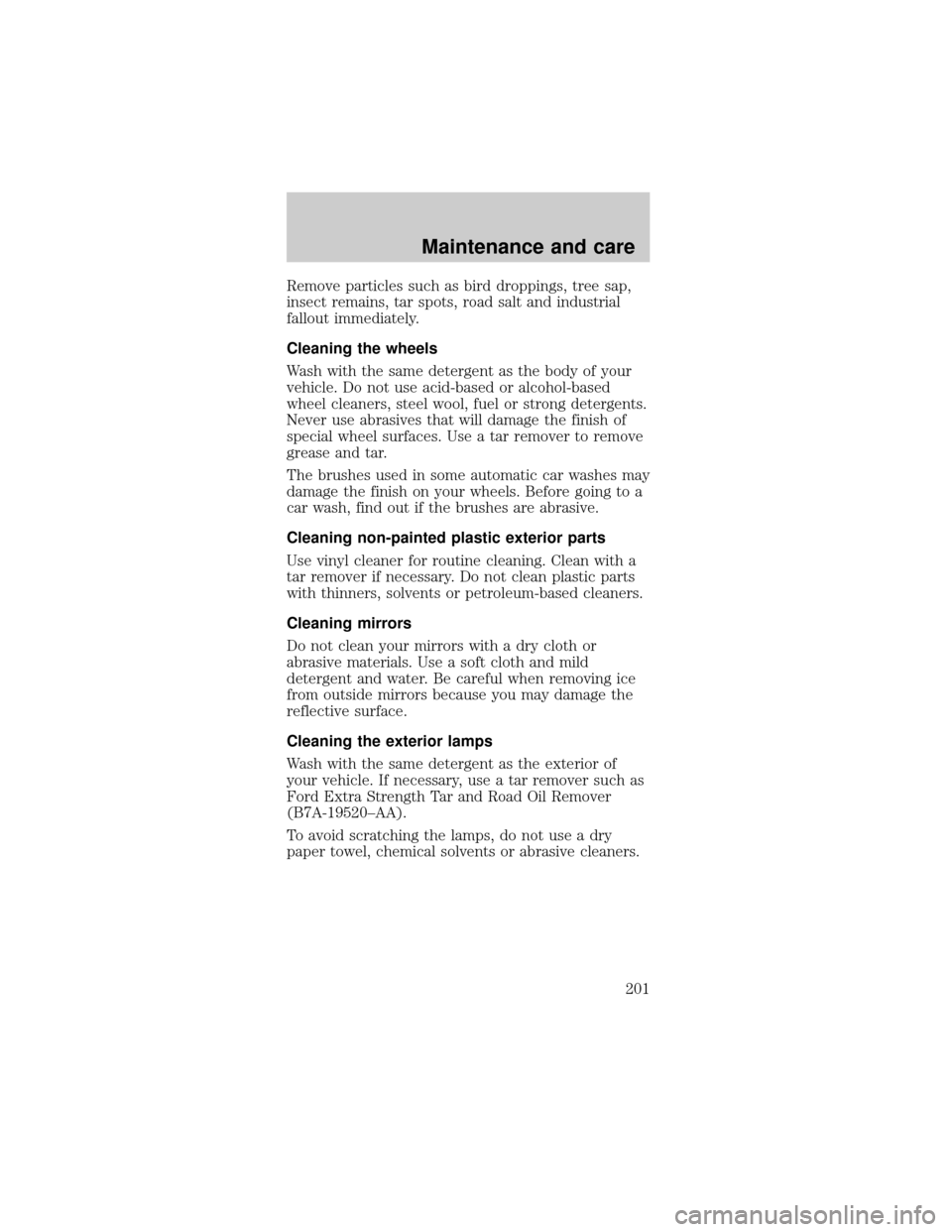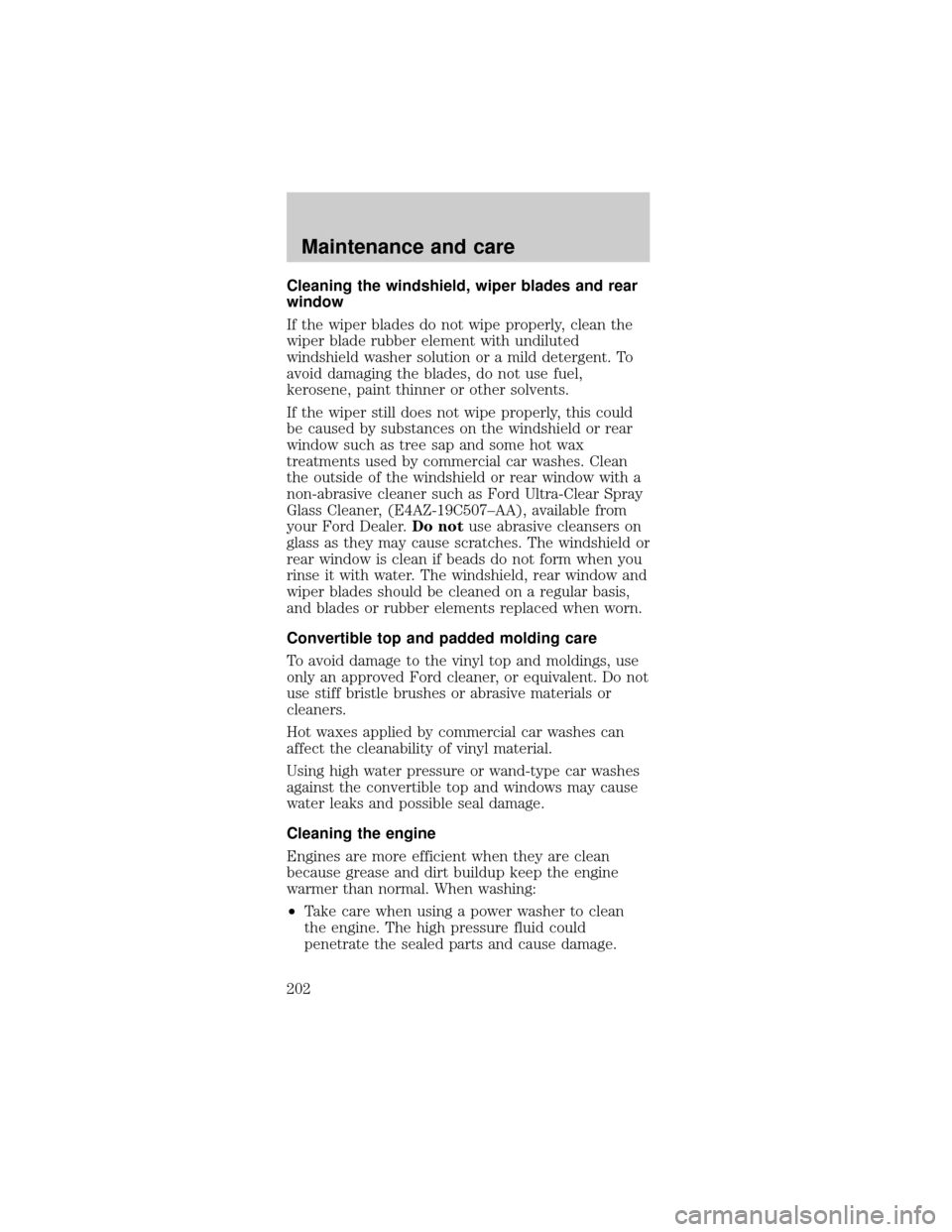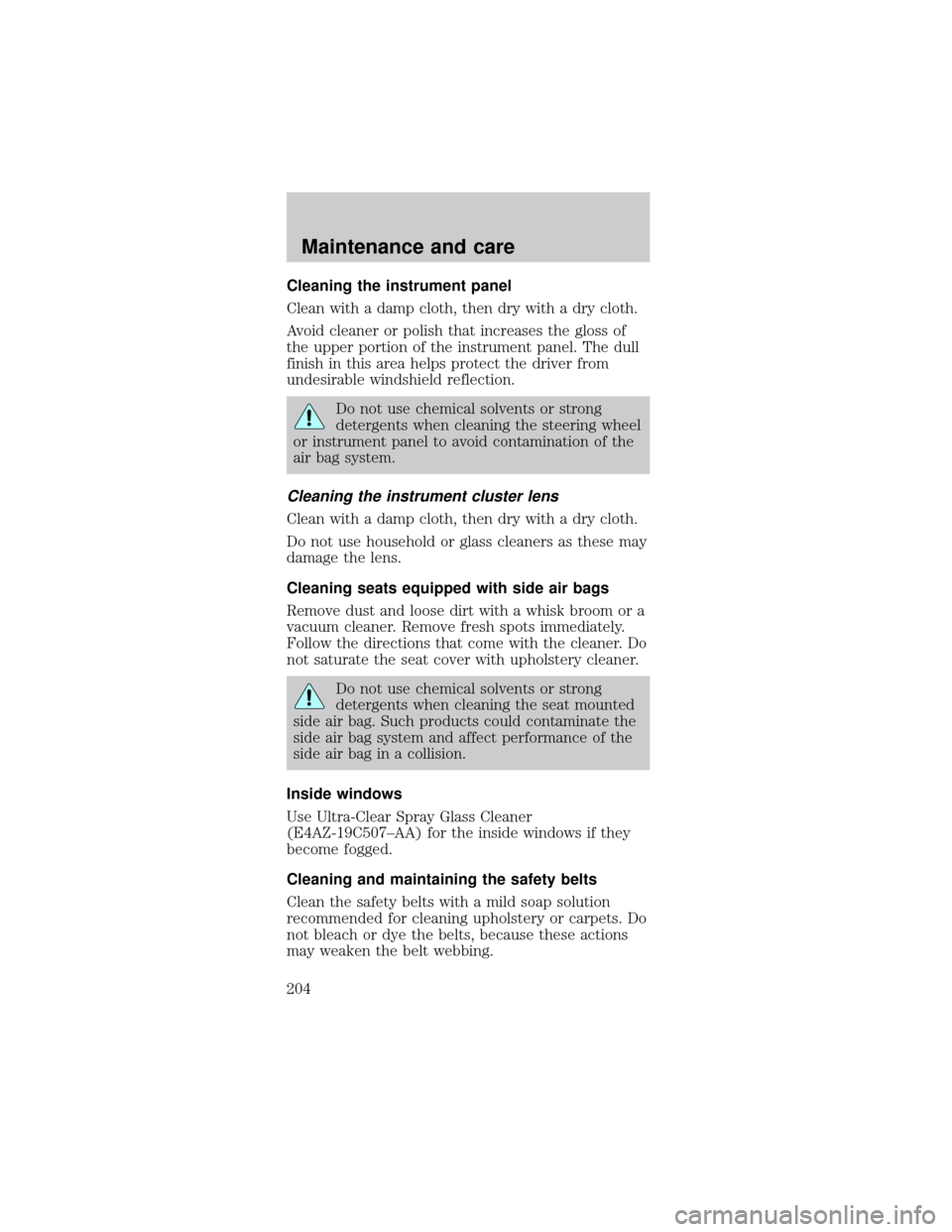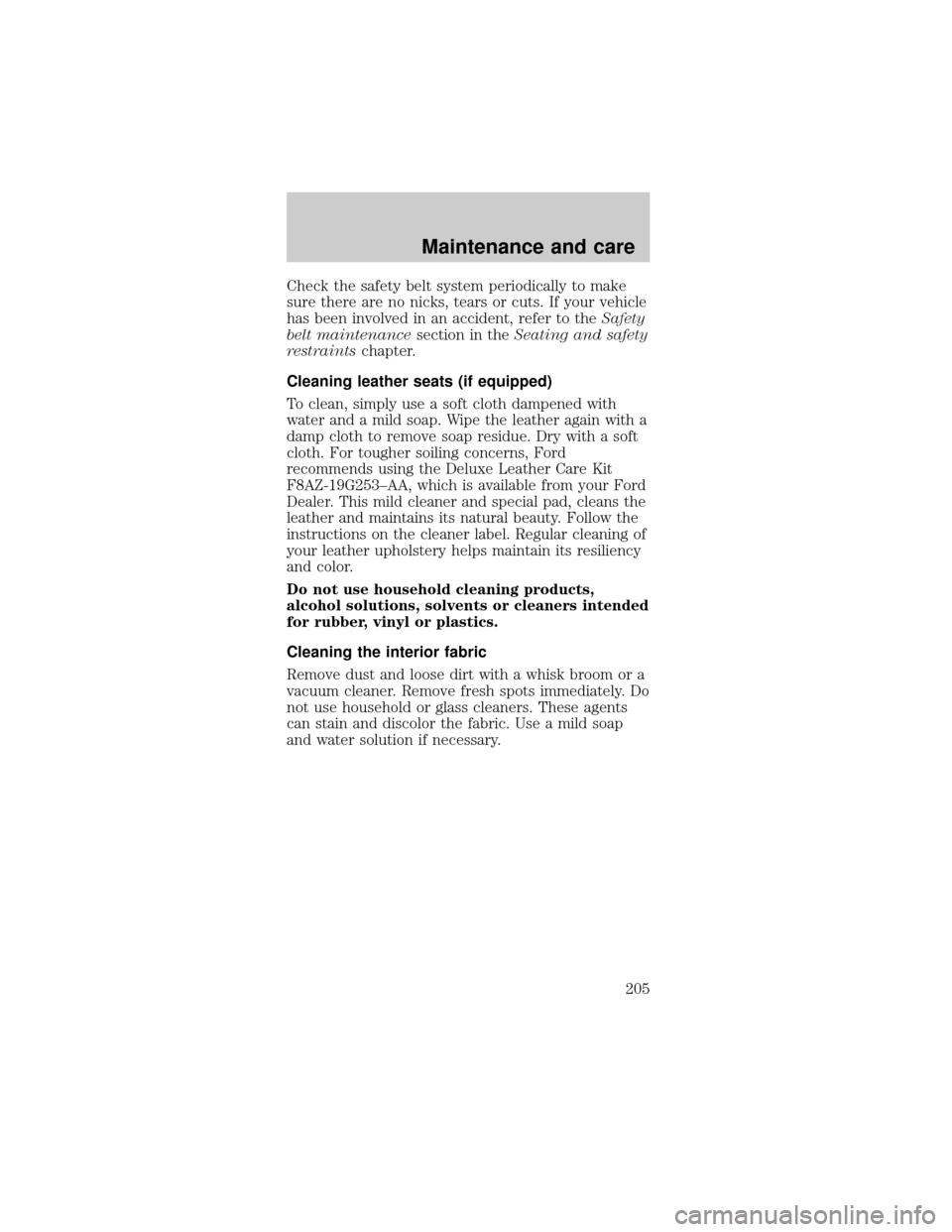Page 200 of 240

Remove any exterior accessories, such as antennas,
before entering a car wash. If you have wax applied
to the vehicle at a commercial car wash, it is
recommended that you clean the wiper blades and
windshield as described inCleaning the wiper
blades and windshield.
After washing, apply the brakes several times to dry
them.
Underbody
Flush the complete underside of vehicle frequently.
Keep body drain holes unplugged. Inspect for road
damage.
Waxing your vehicle
Waxing your vehicle on a regular basis will reduce
minor scratches and paint damage.
Wax when water stops beading on the surface. This
could be every three or four months, depending on
operating conditions.
Use only carnauba or synthetic-based waxes. Use a
cleaning fluid with a clean cloth to remove any bugs
before waxing your vehicle. Use tar remover to
remove any tar spots.
Avoid getting wax on the windshield, or on any
surfaces which appear coarse or bumpy. If you have
wax applied at a commercial car wash, it is
recommended that you clean the wiper blades and
windshield as described inCleaning the wiper
blades and windshield.
Repairing paint chips
Minor scratches or paint damage from road debris
may be repaired with the Ultra Touch Prep and
Finishing Kit (F7AZ-19K507±BA), Lacquer Touch-up
Paint (ALBZ-19500±XXXXA), or Exterior Acrylic
Spray Lacquer (ALAZ-19500±XXXXA) from the Ford
Car Care Chemicals line. Please note that the part
numbers (shown as XXXX above) will vary with your
vehicle's specific coloring. Observe the application
instructions on the products.
Maintenance and care
200
Page 201 of 240

Remove particles such as bird droppings, tree sap,
insect remains, tar spots, road salt and industrial
fallout immediately.
Cleaning the wheels
Wash with the same detergent as the body of your
vehicle. Do not use acid-based or alcohol-based
wheel cleaners, steel wool, fuel or strong detergents.
Never use abrasives that will damage the finish of
special wheel surfaces. Use a tar remover to remove
grease and tar.
The brushes used in some automatic car washes may
damage the finish on your wheels. Before going to a
car wash, find out if the brushes are abrasive.
Cleaning non-painted plastic exterior parts
Use vinyl cleaner for routine cleaning. Clean with a
tar remover if necessary. Do not clean plastic parts
with thinners, solvents or petroleum-based cleaners.
Cleaning mirrors
Do not clean your mirrors with a dry cloth or
abrasive materials. Use a soft cloth and mild
detergent and water. Be careful when removing ice
from outside mirrors because you may damage the
reflective surface.
Cleaning the exterior lamps
Wash with the same detergent as the exterior of
your vehicle. If necessary, use a tar remover such as
Ford Extra Strength Tar and Road Oil Remover
(B7A-19520±AA).
To avoid scratching the lamps, do not use a dry
paper towel, chemical solvents or abrasive cleaners.
Maintenance and care
201
Page 202 of 240

Cleaning the windshield, wiper blades and rear
window
If the wiper blades do not wipe properly, clean the
wiper blade rubber element with undiluted
windshield washer solution or a mild detergent. To
avoid damaging the blades, do not use fuel,
kerosene, paint thinner or other solvents.
If the wiper still does not wipe properly, this could
be caused by substances on the windshield or rear
window such as tree sap and some hot wax
treatments used by commercial car washes. Clean
the outside of the windshield or rear window with a
non-abrasive cleaner such as Ford Ultra-Clear Spray
Glass Cleaner, (E4AZ-19C507±AA), available from
your Ford Dealer.Do notuse abrasive cleansers on
glass as they may cause scratches. The windshield or
rear window is clean if beads do not form when you
rinse it with water. The windshield, rear window and
wiper blades should be cleaned on a regular basis,
and blades or rubber elements replaced when worn.
Convertible top and padded molding care
To avoid damage to the vinyl top and moldings, use
only an approved Ford cleaner, or equivalent. Do not
use stiff bristle brushes or abrasive materials or
cleaners.
Hot waxes applied by commercial car washes can
affect the cleanability of vinyl material.
Using high water pressure or wand-type car washes
against the convertible top and windows may cause
water leaks and possible seal damage.
Cleaning the engine
Engines are more efficient when they are clean
because grease and dirt buildup keep the engine
warmer than normal. When washing:
²Take care when using a power washer to clean
the engine. The high pressure fluid could
penetrate the sealed parts and cause damage.
Maintenance and care
202
Page 203 of 240
²Do not spray with cold water to avoid cracking
the engine block or other engine components.
²Never apply anything to the drive belt (including
belt dressing).
²Cover the highlighted areas to prevent water
damage when cleaning the engine.
²Never wash or rinse the engine while it is
running; water in the running engine may cause
internal damage.
Maintenance and care
203
Page 204 of 240

Cleaning the instrument panel
Clean with a damp cloth, then dry with a dry cloth.
Avoid cleaner or polish that increases the gloss of
the upper portion of the instrument panel. The dull
finish in this area helps protect the driver from
undesirable windshield reflection.
Do not use chemical solvents or strong
detergents when cleaning the steering wheel
or instrument panel to avoid contamination of the
air bag system.
Cleaning the instrument cluster lens
Clean with a damp cloth, then dry with a dry cloth.
Do not use household or glass cleaners as these may
damage the lens.
Cleaning seats equipped with side air bags
Remove dust and loose dirt with a whisk broom or a
vacuum cleaner. Remove fresh spots immediately.
Follow the directions that come with the cleaner. Do
not saturate the seat cover with upholstery cleaner.
Do not use chemical solvents or strong
detergents when cleaning the seat mounted
side air bag. Such products could contaminate the
side air bag system and affect performance of the
side air bag in a collision.
Inside windows
Use Ultra-Clear Spray Glass Cleaner
(E4AZ-19C507±AA) for the inside windows if they
become fogged.
Cleaning and maintaining the safety belts
Clean the safety belts with a mild soap solution
recommended for cleaning upholstery or carpets. Do
not bleach or dye the belts, because these actions
may weaken the belt webbing.
Maintenance and care
204
Page 205 of 240

Check the safety belt system periodically to make
sure there are no nicks, tears or cuts. If your vehicle
has been involved in an accident, refer to theSafety
belt maintenancesection in theSeating and safety
restraintschapter.
Cleaning leather seats (if equipped)
To clean, simply use a soft cloth dampened with
water and a mild soap. Wipe the leather again with a
damp cloth to remove soap residue. Dry with a soft
cloth. For tougher soiling concerns, Ford
recommends using the Deluxe Leather Care Kit
F8AZ-19G253±AA, which is available from your Ford
Dealer. This mild cleaner and special pad, cleans the
leather and maintains its natural beauty. Follow the
instructions on the cleaner label. Regular cleaning of
your leather upholstery helps maintain its resiliency
and color.
Do not use household cleaning products,
alcohol solutions, solvents or cleaners intended
for rubber, vinyl or plastics.
Cleaning the interior fabric
Remove dust and loose dirt with a whisk broom or a
vacuum cleaner. Remove fresh spots immediately. Do
not use household or glass cleaners. These agents
can stain and discolor the fabric. Use a mild soap
and water solution if necessary.
Maintenance and care
205
Page 207 of 240

Fluid Ford Part Name Application Capacity
Rear axle
lubricant
2Motorcraft SAE
80W-90 Premium
Rear Axle
Lubricant7 .5 inch axle 1.5L (3.25 pints)
Motorcraft SAE
75W-140
Synthetic Rear
Axle Lubricant8.8 inch axle 2.0L (4.25 pints)
Fuel tank N/A All 59.4L (15.7
gallons)
Transmission fluid
3Motorcraft
MERCONtVATFAutomatic with
3.8L OHV V6
engine13.1L (13.9
quarts)4
Automatic with
4.6L SOHC V8
engine12.0L (12.8
quarts)4
Motorcraft
MERCONtAT FManual with 3.8L
OHV V6 engine2.6L (5.6 pints)5
Mobil 1
SynthetictAT FManual with 4.6L
SOHC V8 engine3.8L (8.0 pints)5
Windshield
washer fluidUltra-Clear
Windshield
Washer
ConcentrateAll 3.8L (4.0 quarts)
1Add the coolant type originally equipped in your vehicle.2Rear axle lubricants do not need to be checked or
changed unless a leak is suspected, service is required or
the axle assembly has been submerged in water. The axle
lubricant should be changed any time the rear axle has
been submerged in water. Fill 6 mm to 14 mm (1/4 inch to
9/16 inch) below bottom of fill hole. Add 118 ml (4 oz.) of
Additive Friction Modifier C8AZ-19B546-A or equivalent
meeting Ford specification EST-M2C118±A for complete
refill of Traction-Lok axles.
3Ensure the correct automatic transmission fluid is used.
Transmission fluid requirements are indicated on the
dipstick or on the dipstick handle. MERCONtand
MERCONtV are not interchangeable. DO NOT mix
MERCONtand MERCONtV. Refer to your scheduled
maintenance guide to determine the correct service
interval.
4Indicates only approximate dry-fill capacity. Some
applications may vary based on cooler size and if equipped
with an in-tank cooler. The amount of transmission fluid
and fluid level should be set by the indication on the
dipstick's normal operating range.
Capacities and specifications
207
Page 209 of 240

Item Ford part name Ford part
numberFord
specification
Automatic
transmission fluidMotorcraft
MERCONtVATF
2
XT-5-QM MERCONtV
3.8L Manual
transmission fluidMotorcraft
MERCONtAT FXT-2-QDX MERCONt
4.6L Manual
transmission fluidMobil 1
SynthetictAT FN/A N/A
Disc brake caliper
railsSilicone Brake
Caliper Grease
and Dielectric
CompoundD7AZ-19A331-A
(Motorcraft
WA-10)ESE-M1C171-A
Windshield
washer fluidUltra-clear
Windshield
Washer
ConcentrateC9AZ-19550-AC ESR-M17P5-A
1Add 118 ml (4 oz.) of Additive Friction Modifier
C8AZ-19B546-A or equivalent meeting Ford specification
EST-M2C118-A for complete refill of Traction-Lok axles.
Ford design rear axles contain a synthetic lubricant that
does not require changing unless the axle has been
submerged in water.
2Ensure the correct automatic transmission fluid is used.
Transmission fluid requirements are indicated on the
dipstick or on the dipstick handle. MERCONtand
MERCONtV are not interchangeable. DO NOT mix
MERCONtand MERCONtV. Refer to your scheduled
maintenance guide to determine the correct service
interval.
ENGINE DATA
Engine 3.8L OHV V6 engine 4.6L SOHC V8 engine
Cubic inches 232 281
Required fuel 87 octane 87 octane
Firing order 1-4-2-5-3-6 1-3-7-2-6-5-4-8
Spark plug gap 1.3-1.4 mm
(0.052-00.056 inch)1.3-1.4 mm
(0.052-00.056 inch)
Ignition system EDIS Coil on plug
Compression ratio 9.4:1 9.4:1
Capacities and specifications
209